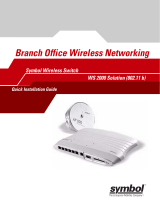
8 Chapter 1
Introduction to AirPort
About the AirPort Software
To extend the range of your network, you can use AirPort Admin Utility to set up
multiple base stations in your network connected to one another wirelessly, known as
a Wireless Distribution System (WDS), or over Ethernet. You can also extend the range
of your wireless network by connecting an Apple-certified external antenna to the
antenna port.
If you connect a USB printer to the base station, computers on the AirPort network can
print to it by selecting the printer via Rendezvous in Printer Setup Utility, located in
Applications/Utilities on a Macintosh. You must use Mac OS X v10.2.3 or later, or
Windows XP or Windows 2000, to print to a USB printer via an AirPort Extreme Base
Station. For information about setting up a computer using Windows XP or Windows
2000, see the document “AirPort Networks for Windows,” that came on the AirPort CD.
Note:
If the base station is set up to receive power over the Ethernet WAN port, do not
connect a printer to the USB port. You cannot print to a USB printer if the base station
is powered over Ethernet.
AirPort Setup Assistant
Use the AirPort Setup Assistant to configure the AirPort Extreme Base Station and to set
up your computer to use AirPort. The Assistant is located in Applications/Utilities on a
computer using Mac OS X.
AirPort Admin Utility
AirPort Admin Utility is an advanced tool for setting up and managing the AirPort
Extreme Base Station. Use AirPort Admin Utility to adjust network, routing, and security
settings and other advanced options. AirPort Admin Utility is located in Applications/
Utilities on a computer using Mac OS X, and in Start > All Programs > AirPort on a
computer using Windows XP or Windows 2000.
AirPort status menu in the menu bar
Use the AirPort status menu to switch quickly between AirPort networks, monitor the
signal quality of the current network, create a Computer-to-Computer network, and
turn AirPort on and off. The AirPort status menu in the menu bar is part of AirPort for
Max OS X.
If your base station supports Power over Ethernet, the following Mac OS X applications
are included on the AirPort Management Tools CD.
AirPort Management Utility
AirPort Management Utility allows network administrators to set up and manage
multiple base stations from a single location.
AirPort Client Monitor
The AirPort Client monitor application monitors the signal strength and transmit rate of
wireless client computers.
LL2870.book Page 8 Thursday, October 28, 2004 12:45 PM





















